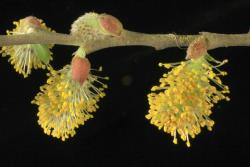- Taxon
- Weed
- Gallery
Trees with bark smooth, branchlets erect, wood ridges dense, 6–62 mm long, averaging about 13–22 mm long on a branchlet. Current year's branchlets green, moderately densely to densely tomentose, 2.8–4.4 mm diameter, average 3.1 mm diameter, measured 150 mm below branchlet apex. Year-old branchlets strong yellow-green to olive-green (UCL117–125), glabrous to densely tomentose, hairs silver, never brown. Flower bud scales 6.5–11 mm long, 4.1–6.0 mm wide, 2.0–5.5 mm deep, ovoid, with 2 angles, dark red-brown (UCL44), densely short-silky-hairy, hairs rubbing off. Leaves alternate. Stipule 6–8 mm long, ovate to obovate and sharply lobed, not persisting. Petiole 4–12 mm long, glands absent, base of petiole expanded. Emerging leaves green, sometimes tinted red-brown, moderately densely tomentose on both surfaces, the hairs slightly crinkled, silver. Proximal leaves entire. Leaf lamina 65–103 mm long, 27–44 mm wide, length to width ratio 1.6–3.0:1, elliptical to obovate; base cuneate; apex acute or acuminate; leaf galls absent; orange rust present in late summer; margins crenate, finely revolute, teeth distant and on or displaced from true margin; upper lamina surface of mature leaves dull, finely bullate, hairs slightly crinkled, silver, appressed to semi-erect, moderately dense initially and becoming sparse, stomata absent; lower lamina surface glaucous, moderately densely tomentose, hairs slightly crinkled, semi-erect, moderately dense and persisting. Catkins male or female, emergence precocious. Flowering branch 26–33 mm long with 3–4 cataphylls. Male catkin 20–32 mm long, 16–27 mm diameter; catkin rachis not visible between flowers. Female catkin 25–40 mm long, 7–9 mm diameter; catkin rachis not visible between flowers. Flower bract 2.6–3.2 mm long, 0.6–1.0 mm wide, distal half dark brown to black, proximal half hyaline, channelled, curved inwards on long axis; apex acute to rounded, dense long-silky hairs on both surfaces and margins, female bract persisting. Male nectary 1, 0.5–0.8 mm long, 0.25–0.4 mm wide, green. Stamens 2, filaments free, hairs absent; anthers 1.0–1.3 mm long, slightly red-tinted before dehiscence. Female nectary 1, 1.0 mm long, 0.4 mm wide, yellow; ovary 3.0–4.0 mm long, densely short-silky hairy; stipe 1.4–2.2 mm long, densely hairy; style base 0.5 mm long, style arms 0.7–0.8 mm long, unlobed to almost completely lobed, stigmas pale yellow-green.
The branchlet wood has dense, long ridges (6–62 mm long, averaging 17 mm long). The ridges can often be seen showing through to the bark surface of larger branches as faint, longitudinal raised lines.
Most similar to Salix atrocinerea. Both are very common in the wild in New Zealand. Both have dense and long wood ridges. Both have obovate leaves when young and elliptical mature leaves, and are variable in the density and persistence of hairs on the leaf surfaces. Salix cinerea never has brown leaf hairs, while S. atrocinerea has some brown hairs present on the lower or upper or both surfaces of the leaf. The year-old stems of S. cinerea tend to retain their hairs, giving the stems a grey appearance, and the surface becomes dirty due to trapped wind-blown soil particles. In contrast, S. atrocinerea has year-old stems that are dark red and glabrous. The two overlap in terminal branchlet robustness, but S. cinerea has a statistically significant thicker year-old branchlet diameter. In S. cinerea mean branchlet diameter is 3.1 mm (range 2.3–4.4 mm measured 150 mm from branchlet apex), while in S. atrocinerea mean branchlet diameter at the same position is 2.7 mm (range 2.2–3.6 mm). Salix atrocinerea tends to have less dense hair cover on the lower side of the leaves at all stages of leaf development. The hairs are more crumpled and lie in random directions, while in S. cinerea they tend to be straighter and either aligned towards the leaf apex or almost erect. Salix cinerea appears to have a narrower ecological range than S. atrocinerea. In the UK and in New Zealand it is found on stream banks, and in marshes, bogs, and swamps, while S. atrocinerea is found in such wetlands, but also occurs in better-drained soils.
Similar to Salix ×reichardtii in having only silver hairs on the leaves. The hybrid differs from S. cinerea in having sparse, short wood ridges. The branchlets of the hybrid are more slender (average 2.8 mm diameter 150 mm below branchlet apex) than those of S. cinerea (on average 3.1 mm diameter).
Northland (Waitangi 1967, Dargaville 1970), Auckland (Piripiri 1984), Gisborne (Ōpōtiki 1975), Taranaki (Whanganui River 2011), Southern North Island (Hutt River 1953), Western Nelson (Ōpārara River 1985), Westland (Kumara 2016, Hokitika 1976, Franz Josef 1970), Canterbury (Christchurch and environs 1963–2016, Springston 1972, Timaru 1956, Peel Forest 1984, Oamaru 1956), Southland (Invercargill 1969, Bluff 1969, Riverton 1973).
Salix cinerea is listed by the Ministry for Primary Industries on the National Pest Plant Accord list (it cannot be traded), and the Department of Conservation lists it as an unwanted organism. Colin Meurk (pers. comm., 2019) believes this is one of New Zealand's worst woody weeds and if left unchecked would completely invade swamps like Travis Swamp (north-east Christchurch City).
First collection: CHR 84314, A. J. Healy 53/911, 21 September 1953, Hutt River, Akatarawa, "tree 12 m tall".
First publication: Sykes (1982) believed that Cheeseman (1925) provided the first published record of the species, as Salix caprea. Because of the difficulty of identifying species and hybrids in the S. cinerea complex, records without vouchers are unreliable.
Flowering: Early September–early November.
Tetraploid, 2n = 76 (CCDB based on 24 counts), confirmed by flow cytometry using PN210, PN324 and CHR 639122.

















